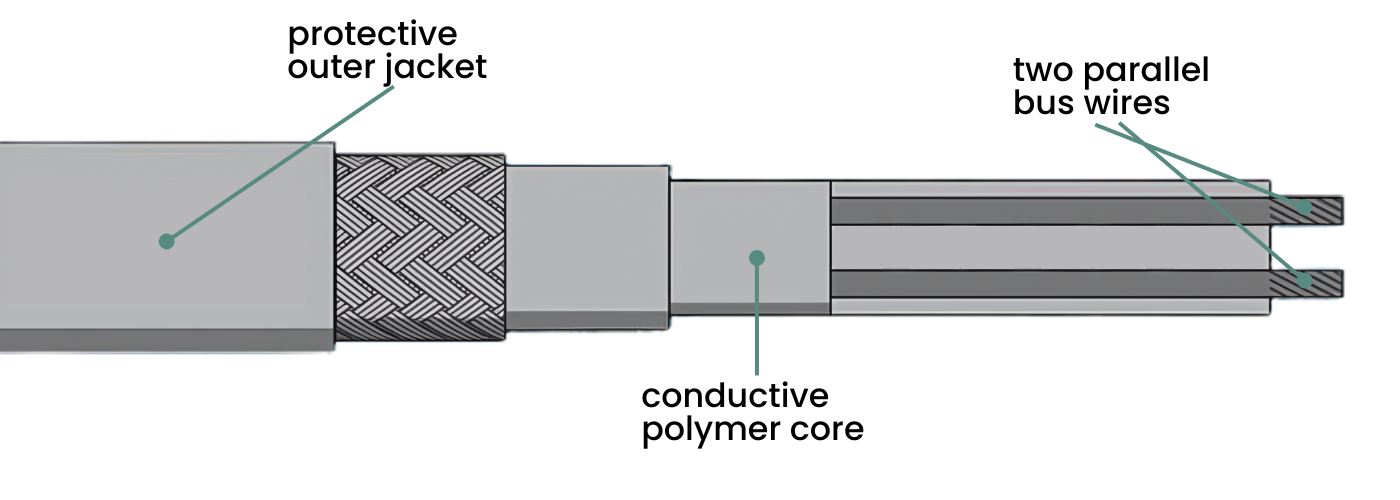Winter’s chill can wreak havoc on pipes and gutters. That’s where self-regulating heat tape comes in.
This clever technology adapts its heat output to temperature changes, preventing freezes without wasting energy. It’s a simple solution to a potentially costly problem.
But how exactly does it work?
We’ll break it down and see why it’s becoming a go-to for homeowners and businesses alike.
Key Notes
- Self-regulating heat tape’s automatic adjustment changes heat output based on ambient temperature.
- It conserves energy by increasing heat in the cold and reducing it in warm conditions.
- The tape is durable with a conductive polymer core, bus wires, and a protective jacket.
- Versatile applications include pipe freeze prevention and snow and ice melting on roofs and gutters.
What’s It All About?
Self-regulating heat tape, also known as heat trace cable, is designed to:
- Prevent pipe freezing
- Maintain process temperatures
- Ensure smooth liquid flow in various settings
Unlike traditional heating cables, it automatically adjusts heat output based on ambient temperature changes, making it an energy-efficient solution for residential, commercial, and industrial applications.
The tape changes its electrical resistance as temperatures fluctuate. Its primary technology is a conductive core made from thermoplastic polymers that alter its conductivity with temperature shifts.
As temperature drops, the polymer contracts, increasing conductivity, and heat output. When the temperature rises, the polymer expands, reducing conductivity and heat output.
This dynamic response sets it apart from constant wattage heat tape, which provides steady heat output regardless of temperature.
Heat Tape Components - The Nuts And Bolts
Self-regulating heat tape is built to last. It consists of a conductive polymer core, two parallel bus wires, and a protective outer jacket.

The core does the heavy lifting of adjusting heat, while the bus wires keep electricity flowing. The jacket acts as a shield against environmental factors.
The materials used are chosen for their durability and performance. The core is typically carbon-based, selected for its reliable conductivity changes. The outer jacket is made of tough plastics that withstand UV rays, chemicals, and moisture.
The Smart Part
The conductive polymer core is the brain of self-regulating heat tape. It ensures more heat is delivered where it’s needed and less where it’s not. This clever design prevents overheating and saves energy, making the whole system safer and more efficient.
Scan this graph to understand how self-regulating heat tape changes with ambient temperatures:

Power Specs
You’ll find self-regulating heat tape in various voltage and power options to suit different needs. Common voltages are 110-120V and 220-240V, with power outputs usually ranging from 3 to 30 watts per foot.
The tape’s electrical resistance changes with temperature, allowing it to adapt its power output to the surrounding environment.
Ready To Outsmart Winter's Freezing Grip?
Getting It Up and Running
Here’s a quick overview of how to install self-regulating heat tape:
- Start with the prep work by measuring your pipe or surface and cutting the tape to fit.
- Attach the tape along the pipe using special clips or ties. Keep it evenly spaced and avoid overlaps.
- Cover the tape with insulation to boost efficiency and protect it.
- Power up by connecting the tape to an electrical source and using the right connectors.
Where Can You Use It?
There are numerous applications for the use of self-regulating heat tape. Here are some of them:
- Keeping pipes frost-free in homes, businesses, and industrial settings.
- Preventing ice dams on roofs and gutters.
- Melting snow on walkways, driveways, and stairs.
- Maintaining steady temperatures in industrial processes, from chemical plants to food factories.
Efficiency and Performance
One of the main benefits of self-regulating heat tape is its energy-efficient performance. It adjusts its heat output based on the surrounding temperature, using less power when it’s warmer and ramping up only when needed.
This smart feature reduces energy use compared to constant wattage tape, which maintains constant heat regardless of temperature.
KPIs of Self-Regulating Heat Tape

Let’s discuss self-regulating heat tape’s key performance indicators
Response Time
This refers to how quickly heat tape adjusts its temperature output in response to changes in ambient temperature. A shorter response time ensures this tape can quickly provide the heat needed to prevent freezing or maintain desired temperatures.
This is particularly important in environments where temperatures fluctuate rapidly.
Temperature Range
Self-regulating heat tape is designed to handle various temperatures without malfunctioning. Generally, you can put it to the test in ambient temperatures as low as -40°F (-40°C) while it maintains a surface temperature of up to 150°F (65°C).
Some high-performance tape handles the heat at 185°F (85°C) or even higher under certain conditions. This makes self-regulating heat tapes versatile and reliable in harsh and mild conditions.
Energy Efficiency
The high energy efficiency of self-regulation heat tape reduces operational costs and minimizes environmental impact, making it sustainable and cost-effective over its lifespan.
Factors Influencing Performance
Ambient Temperature
Ambient temperature directly affects the heat tape’s power output. In colder temperatures, the tape increases its heat production; in warmer conditions, it reduces output to save energy.
Quality of Insulation
High-quality insulation that comprehensively covers the tape’s surface reduces heat loss. This ensures that any heat generated is effectively used for its intended purpose without wastage.
The Environment
The setting in which heat tape is used plays a large role in its performance. Factors such as exposure to moisture, chemicals, or physical wear can affect your tape’s durability and efficiency.
Fortunately, self-regulating heat tapes are designed to handle various environments without underperforming. They include industrial settings, residential roofs, gutters, and pipes.
Crunching the Numbers
While the initial investment in self-regulating heat tape may be higher than that in other heating solutions, in the long run, it pays off. There are three main reasons for this.
- Energy Savings: As this smart tape adjusts its output, you’re not paying to heat things when you don’t need to.
- Low Maintenance: It’s pretty self-sufficient, which means fewer repair bills down the road.
- Damage Control: By preventing frozen pipes and other cold-weather issues you can avoid potentially expensive structural repairs to your property.
Self-Regulating vs Constant Wattage
| Feature | Self-Regulating Heat Tape | Constant Wattage Heat Tape |
|---|---|---|
| Heat Output | Varies with ambient temperature | Constant |
| Energy Consumption | Variable, more efficient in milder conditions | Constant, higher in mild conditions |
| Safety | High, due to self-regulating nature | Requires careful monitoring and thermostat |
| Installation Complexity | Easier, no thermostat required | Requires thermostat |
| Suitable Applications | Residential, commercial, complex installations | Simple installations, consistent heating needs |
Troubleshooting - Common Heat Tape Problems
Self-regulating heat tape can malfunction, usually due to an electrical fault or physical damage. Here are some common issues:
No Heating
- Check the power connection. Is it plugged in and turned on?
- Make sure the tape is installed correctly and isn’t damaged.
Electrical Gremlins
- Look for short circuits or loose connections.
- If you spot any damaged parts, swap them out.
Wear and Tear
- Keep an eye out for signs of damage, like cuts or worn spots.
- Replace any damaged sections to stop them from becoming a safety hazard.
Regular inspections are important if you want your heat tape to keep running smoothly. Give it a once-over now and then to catch any wear, damage, or corrosion early.
Make sure the insulation is still doing its job, and if you spot any trouble spots, replace them. This helps to keep your heat tape efficient and long-lasting.
Frequently Asked Questions
Does self-regulating heat trace need a thermostat?
Self-regulating heat trace does not strictly require a thermostat because it automatically adjusts its heat output based on ambient temperature. However, using a thermostat can enhance energy efficiency and provide additional control over the system.
What are the benefits of self-regulating heat tape?
Self-regulating heat tape offers energy efficiency, safety, and versatility. It adjusts heat output based on temperature, preventing overheating and conserving energy. It is suitable for a wide range of applications, from residential pipe protection to industrial process maintenance.
Conclusion
Self-regulating heat tape works efficiently to keep winter’s chill at bay. It’s not just about preventing frozen pipes – it’s a versatile technology that adapts to temperature changes, saving energy and hassle. From residential use to industrial applications, this clever tape has got you covered.
While it may cost more upfront, the long-term benefits are clear: energy savings, low maintenance, and protection against costly damage. Remember, proper installation and regular check-ups are key to getting the most out of your heat tape.
With this knowledge in your toolkit, you’re well-equipped to make an informed decision. Have a look at our self-regulating heat tape products to find the perfect solution for your needs.






